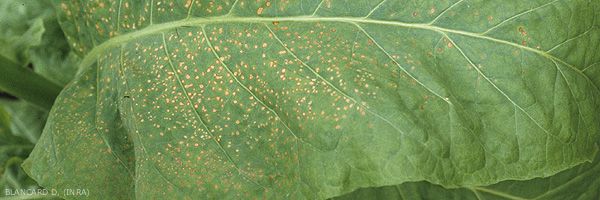
Pollution spots (weather fleck)
Producers and agronomists tend to group a number of symptoms, sometimes quite different, for which they have not always been able to accurately identify the cause under the name of pollution spots ("weather fleck") or physiological spots. In fact, the symptoms of "weather fleck" are induced by ozone (O3) which is an air pollutant affecting many plants. This gas is produced secondarily in the atmosphere as a result of chemical reactions involving primary pollutants such as nitrogen dioxide (NO2) and hydrocarbons (HC), this under the influence of solar radiation. In U.S. it is considered the most important air pollutant. It enters the leaves through the stomata and affects mesophyll cells. It causes many small spots, located mostly on the upper side of lamina, sometimes contiguous and located along the midrib and secondary veins (figures 1 and 2). These spots are often found on basal leaves. Their colour changes over time and turns fairly quickly from brown at first, to greyish white afterwards (figure 3). When the attacks are very severe, whole leaves are affected. They age prematurely and fall.
There are differences in ozone sensitivity between the three types of tobacco (dark tobacco seems to be less sensitive), but also between varieties of the same type. For example Burley 21 variety is much more sensitive than the genotype Kentucky 17. Some sensitive varieties were used as biological indicators of environmental pollution by ozone, as is the case, for example, of Bel W3 Virginia type tobacco.
The disease often occurs following prolonged rainy periods and during the active growth phase of tobacco, during which tissues are particularly succulent.
There are other air pollutants causing fairly comparable damage in tobacco, in particular nitrogen oxide (NO2) and sulfur dioxide (SO2). The latter seems to act synergistically with ozone. Unfortunately, there is no control method to cope with this non-parasitic disease. It is advised to grow least sensitive varieties in areas where air pollution is high.
Note that apart from classical spots attributed to "weather fleck", a number of variants have been described, both in the USA and Japan (figures 4 and 5). It has not always been possible to associate any environmental pollution to their appearance. For this reason, some Japanese observers prefer to speak about "physiological spots". They probably have a non-parasitic origin, and some do not seem transmissible after hybridization. They are likely to occur at the beginning of culture or near harvest. They were found in quite different situations, but some common factors emerge: low phosphorus content of soil, special climatic conditions (high rainfall, prolonged period of high humidity ...)
The situation observed in France is quite comparable. Given the diversity of spots observed, with non-parasitic origin, one can sometimes blame the effects of "weather fleck", but also, in some contexts, the impact of physiological disorders whose causes are never easy to determine.





